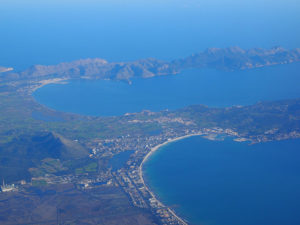
National Park of Cabrera
The well-protected bay of the Balearic island of Cabrera will make a pleasant visit to this last virgin corner of the Mediterranean, where access is only possible by sea.
Its name owes its origin to the mountain goats that inhabited the island, now disappeared.
An archipelago consisting of 19 islands was named after it. in 1991 this area was declared Spain’s first Maritime-Terrestrial National Park.

Crystal clear water, calm and relaxing beaches of S’Espalmador, Sa Platgeta or Cas Pages, dolphins and turtles, thousands of fish, hedgehogs, octopuses, crabs and cuttlefish among many other species, rocks covered with scrub, in which inhabits Balearic lizards, a large number of birds of prey and seabirds. A medieval fortress is open to tourists, and at 72 m high the ruins of the tower provides grate panoramic views. A beautiful underwater grotto Sa Cova Blava with its impressive seabed.

It is a privileged and very protected place, where to spend a wonderful day or a great week. One week is a maximum period of stay on the island allowed and only in low season.
For those who would like to explore the island on foot, a walk is a perfect option to discover its beauty and history.
In the Vth century, to the island, where the local population was engaged in the extraction of salt and the production of fish sauce, came the monks and founded a monastery that existed until the VIII century. Until the remains of this monastery were discovered in 1999, the only evidence of its existence was a letter from Pope Gregory I, dated to the year 603, in which the Pope accuses the monks of leading a lecherous life full of crimes.
The disappearance of the monastery coincided with the beginning of the conquest of the Balearic Islands by the Cordoba Caliphate. How there lived on the island during the period of Muslim rule, we can only guess. The next mention of Cabrera dates to 1229. King of Aragon and Count of Barcelona, Jaime I, began a campaign of Christian reconquest of the Balearic Islands and subsequently gave the head of the Cathedral of Tarragona full control of the island.
In the 13th and 14th centuries, the island of Cabrera and its natural port were used by Berber pirates as a base from which to attack the coasts of Mallorca and passing ships. For this reason, in the second half of the 14th century a castle was built at the entrance to the port with the aim of alerting Majorca with smoke and fire signals that the Berber pirates were approaching. Of course, it was also the first place was attacked by them, so it was under rebuilding several times.

During the Napoleonic Wars, the island of Cabrera was turned into a notorious prison for 13 thousand French soldiers who had fought in the Battle of Bailén. From 1808 to 1814, three out of every four prisoners died from hunger and disease.
Currently the Cabrera Archipelago Terrestrial Maritime National Park is a virgin place with the most peculiar wild nature.
Only staff lives on this desert island.
To preserve the unique species of marine fauna, anchoring is prohibited near the archipelago.
There are 50 buoys in Cabrera Bay those indicate with their colors the size of the boats and yachts that can moor them.
Permits are issued by the Balearic Islands Transport Department for one or two days, depending on the season.
Diving or fishing is not allowed without obtaining a permit.
There are no hotels or restaurants on the island. The only accommodation The Albergue de Cabrera only has 12 rooms and maintains essential rules: pets are prohibited, parties and all activity that disturbs the tranquility of clients are totally forbidden, a schedule of silence from midnight to seven in the morning is strictly followed.
The Cabrera shelter’s rooms are priced at € 60 per night during high season and € 50 per night during the low season. However, if clients cannot return from La Cabrera due to the state of the sea, the stay at the shelter will be extended free of charge until transport can be resumed.


 Previous Post
Previous Post
